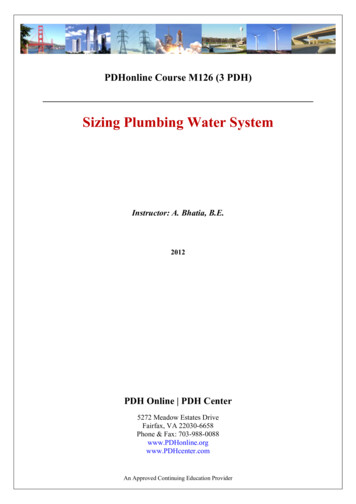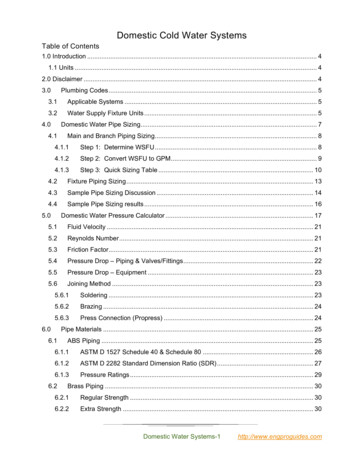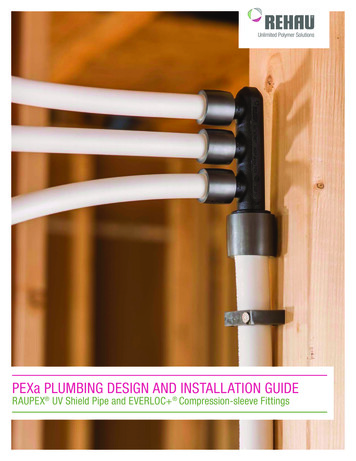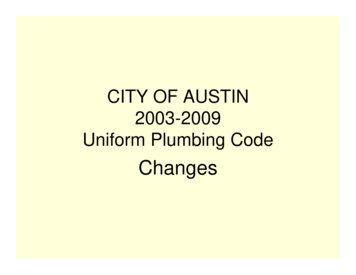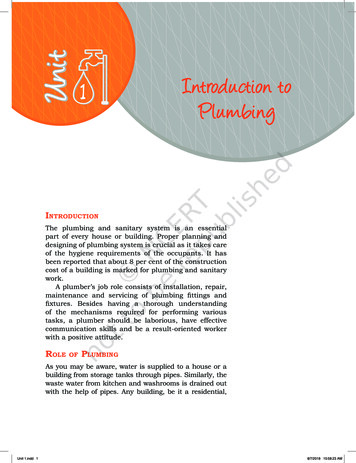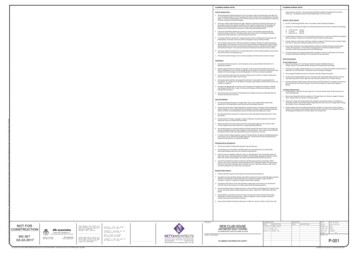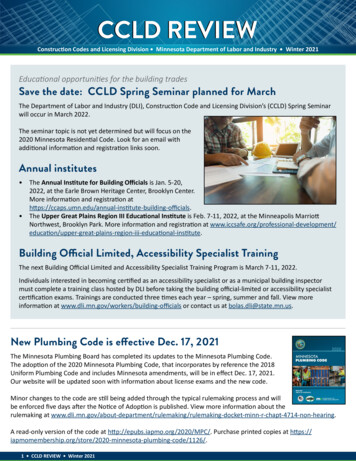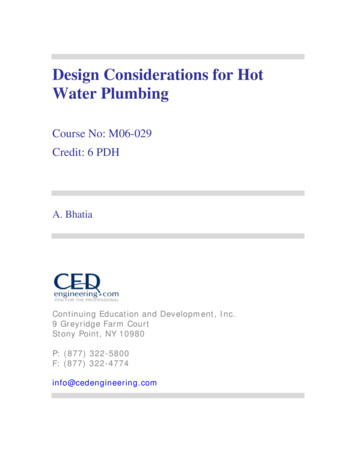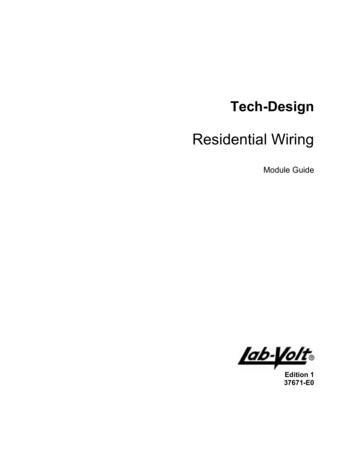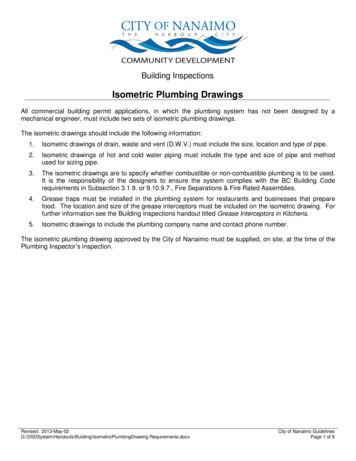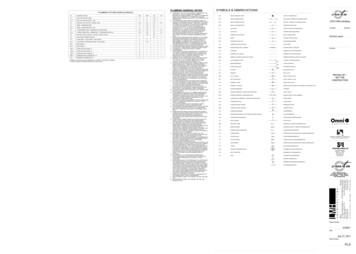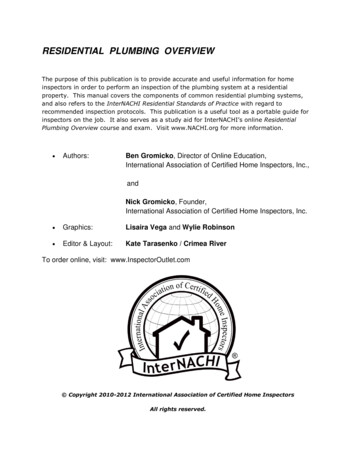
Transcription
1 RESIDENTIAL PLUMBING OVERVIEWThe purpose of this publication is to provide accurate and useful information for homeinspectors in order to perform an inspection of the plumbing system at a residentialproperty. This manual covers the components of common residential plumbing systems,and also refers to the InterNACHI Residential Standards of Practice with regard torecommended inspection protocols. This publication is a useful tool as a portable guide forinspectors on the job. It also serves as a study aid for InterNACHI’s online ResidentialPlumbing Overview course and exam. Visit www.NACHI.org for more information.Authors:Ben Gromicko, Director of Online Education,International Association of Certified Home Inspectors, Inc.,andNick Gromicko, Founder,International Association of Certified Home Inspectors, Inc.Graphics:Lisaira Vega and Wylie RobinsonEditor & Layout:Kate Tarasenko / Crimea RiverTo order online, visit: www.InspectorOutlet.com Copyright 2010-2012 International Association of Certified Home InspectorsAll rights reserved.
2 RESIDENTIAL PLUMBING OVERVIEWSection 1:General Comments.3Section 2:InterNACHI Standards of Practice. .6Section 3:Glossary of Terms .9Section 4:Fixtures .21Section 5:Water Heaters . . 42Section 6:Potable Water .Section 7:Sanitary Drainage . . 78Section 8:Vents . . 89Section 9:Traps . . .5693Section 10: Protection . . 97Section 11: Plumbing Support . . .97Section 12: Storm Drainage . . . .100Section 13: Dryer System . . .102Section 14: Fuel . . 104Section 15: Procedural Inspection Checklist . . 116
3 SECTION 1: GENERAL COMMENTSThis is not a code-compliance course. There are many plumbing codes, and they changeregularly. This course should provide you with a sound introduction to standards andrequirements for the proper installation and inspection of residential plumbing. You willlearn the components of a plumbing supply and drainage system. You will learn aboutwater heaters, fixtures and faucets. An inspection report should describe and identify, inwritten format, the inspected plumbing system of the dwelling, and should also identifymaterial defects observed.
4 IntroductionThe term “plumbing” refers to the practice, materials, and the collective system of piping,fixtures, appliances, equipment, fittings and components within a structure that are relatedto the sanitary drainage system, storm drainage, venting systems, and public or privatewater supply systems.The word “plumbing” comes from the Latin word plumbum, which is the element lead, andwas so named because lead was used extensively in the development of piping systems.The practice of installing pipes and using the piping materials became known as plumbing.Piping, fittings, devices, faucets, tanks, containers and receptacles that are used to supply,distribute, receive and transport potable water, liquid wastes and solid wastes are nowconsidered plumbing.A plumbing fixture could refer to a receptacle or device that is either permanently ortemporarily connected to the water distribution system of the property, and which demandsa supply of water. Or the fixture could discharge wastewater, liquid-suspended wastematerials or sewage to the drainage system of the property. The fixture could also requireboth a water supply connection and a discharge to the drainage system of the property.Plumbing fixtures include water closets, urinals, bidets, lavatories, sinks, showers, bathtubsand floor drains.A separate class of plumbing fixtures defined as plumbing appliances includes clotheswashers, dishwashers, water heaters, water softeners, hot water dispensers, garbagedisposals, and water purifiers.Four DefectsThere are four basic defects thatcan exist in a plumbing systemthat should be identified in aninspection. They include:1. a leak;2. inadequate water supply;3. water contamination; and/or4. the incorrect installation of acomponent.Photo above by InterNACHI member William Warner
5 QUIZ on SECTION 11. T/F: This is a code-compliance plumbing course.TrueFalse2. “Plumbing” comes from the Latin word meaning .”lead””toilet””aluminum”3. T/F: Water contamination is considered a defect.TrueFalseAnswer Key to Quiz on Section 11. T/F: This is a code-compliance plumbing course.Answer: False2. “Plumbing” comes from the Latin word meaning “lead.”3. T/F: Water contamination is considered a defect.Answer: True
6 SECTION 2: InterNACHI STANDARDS of PRACTICEThe following is excerpted from the InterNACHI Standards of Practice, effectiveDecember 7, 2004.2.6. PlumbingI. The inspector shall:A. inspect and determine if the water supply is public or private;B. verify the presence of and identify the location of the main water shut-off valve;C. inspect the water heating equipment, including venting, connections, energy-sourcesupply system, and seismic bracing, and verify the presence or absence of temperaturepressure relief valves and/or Watts 210 valves;D. flush toilets;E. water-test a representative number of sinks, tubs and showers for functional drainage;F. inspect the interior water supply, including all fixtures and faucets;G. inspect the drain, waste and vent systems, including all fixtures;H. describe any visible fuel-storage systems;I.inspect the drainage sump pumps, and test pumps with accessible floats;J.inspect and describe the water supply, drain, waste and main fuel shut-off valves, aswell as the location of the water main and main fuel shut-off valves;K. inspect and report as in need of repair deficiencies in the water supply by viewing thefunctional flow in two fixtures operated simultaneously;L. inspect and report as in need of repair deficiencies in installation and identification of hotand cold faucets;M. inspect and report as in need of repair mechanical drain stops that are missing or do notoperate if installed in sinks, lavatories and tubs; andN. inspect and report as in need of repair commodes that have cracks in the ceramicmaterial, are improperly mounted on the floor, leak, or have tank components which donot operate.
7 II. The inspector is not required to:A. light or ignite pilot flames;B. determine the size, temperature, age, life expectancy, or adequacy of the water heater;C. inspect interiors of flues or chimneys, water softening or filtering systems, well pumps ortanks, safety or shut-off valves, floor drains, lawn sprinkler systems or fire sprinklersystems;D. determine the exact flow rate, volume, pressure, temperature, or adequacy of the watersupply;E. determine the water quality or potability or the reliability of the water supply or source;F. open sealed plumbing access panels;G. inspect clothes washing machines or their connections;H. operate any main, branch or fixture valve;I.test shower pans, tub and shower surrounds or enclosures for leakage;J. evaluate the compliance with local or state conservation or energy standards, or theproper design or sizing of any water, waste or venting components, fixtures or piping;K. determine the effectiveness of anti-siphon, backflow prevention or drain-stop devices;L. determine whether there are sufficient cleanouts for effective cleaning of drains;M. evaluate gas, liquid propane or oil storage tanks;N. inspect any underground or concealed fuel supply systems;O. inspect any private sewage waste disposal system or component thereof;P. inspect water treatment systems or water filters;Q. inspect water storage tanks, pressure pumps or bladder tanks;R. evaluate time to obtain hot water at fixtures, or perform testing of any kind to waterheater elements;S. evaluate or determine the adequacy of combustion air;T. test, operate, open or close safety controls, manual stop valves and/or temperature orpressure-relief valves;U. examine ancillary systems or components, such as, but not limited to, those relating tosolar water heating, or hot water circulation; orV. determine the existence or condition of polybutylene plumbing.
8 QUIZ on SECTION 21. The inspector is required to all the toilets.unbolt and liftflushuseclean2. T/F: The inspector is required to light or ignite a pilot light.TrueFalse3. T/F: An inspector is not required to determine whether the water supply is public or private.TrueFalse4. T/F: According to the InterNACHI Standards of Practice, the existence of polybutyleneplumbing in a dwelling is required to be determined by the inspector.TrueFalseAnswer Key to Quiz on Section 21. The inspector is required to flush all toilets.2. T/F: The inspector is required to light or ignite a pilot light.Answer: False3. T/F: An inspector is not required to determine whether the water supply is public orprivate.Answer: False4. T/F: According to the InterNACHI Standards of Practice, the existence of polybutyleneplumbing in a dwelling is required to be determined by the inspector.Answer: False
9 SECTION 3: GLOSSARY OF TERMSABS (acrylonitrile butadiene styrene): rigid, black plastic pipe used for drain, wasteand vent lines.access panel: an opening in the wall or ceiling near the fixture that allows access forservicing the plumbing/electrical system.accessible: different from “readily accessible” in that there is some obstruction, such as adoor, access panel, ladder, etc.access cover: removable plate to permit access to a pipe or pipe fitting for the purposesof inspection, maintenance, repair or replacement.activate: to turn on, supply power, or enable systems, equipment, or devices to becomeactive by normal operating controls. Examples include turning on the gas or water supplyvalves to the fixtures and appliances, and activating electrical breakers or fuses.adaptor: a fitting that unites different types of pipe together, such as ABS to cast-ironpipe.adversely affect: constitute, or potentially constitute, a negative or destructive impact.aerator: an apparatus that mixes air into flowing water; it is screwed onto the end of afaucet spout to help reduce splashing.air-admittance valve: one-way valve designed to admit air into the plumbing system toprotect the traps from siphonage; a device used as an alternative to vents for individualfixtures and branches in the plumbing drainage system.air gap: an unobstructed vertical distance through the free atmosphere between theoutlet of the waste pipe and the flood-level rim of the receptacle into which the waste pipeis discharging.air chamber: a vertical, air-filled pipe that prevents water hammer by absorbingpressure when water is shut off at a faucet or valve.anti-scald: a valve that restricts water flow to help prevent burn injuries. See pressurebalancing valve and thermostatic valve. In some areas, plumbing codes require antiscald valves. Speak to a professional in your area for more information and help with coderequirements.anti-siphon: a device that prevents wastewater from being drawn back into supply linesand possibly contaminating the water supply.aperture: an opening in a pipe.appliance: an apparatus, device or equipment operated by use of electricity or fuel gasto produce heat, light, power, refrigeration or air conditioning.
10 approved: accepted by the code official, third-party agency, authority having jurisdiction(AHJ), or conforming to a standard, such as ANSI.backflow: the flow of liquids in potable water distribution piping in reverse of theirintended path. There are two types of pressure conditions that cause backflow: backsiphonage and back-pressure.backflow preventer: a device or means to prevent backflow into the potable watersupply.back-pressure: pressure created in a non-potable system in excess of the water supplymains causing backflow. Back-pressure can be created by mechanical means (such as apump), by static head pressure (including an elevated tank), or by thermal expansion froma heat source (such as a water heater).back-siphonage: the backflow of water caused by system pressure falling belowatmospheric pressure. Atmospheric pressure supplies the force that reverses the flow.basket strainer: basket-shaped strainer with holes allowing water to drain while catchingfood or other solids; can also be closed to fill the sink with water.bell reducer: in plumbing, a fitting shaped like a bell which has one opening of a smallerdiameter used to reduce the size of the pipe in the line, and the opposite opening of largerdiameter.bidet:a toilet-like plumbing fixture designed to promote posterior hygiene; not a toilet.building drain: the part of the drainage system that receives the discharge from insidethe dwelling and transports it to the building sewer, and ends 30 inches outside thedwelling’s foundation wall.building sewer: that part of the drainage system that extends from the end of thebuilding drain onward.cistern: reservoir for water; common in houses built prior to the 1950s in the Midwest.cleanout: a plug in a trap or drain pipe that provides access for the purpose of clearingan obstruction.closet bend: a curved fitting that connects the closet flange to the toilet drain.closet bolts: bolt whose head is fitted to a closet flange and protrudes up through a toiletbase. A nut is tightened around it on the toilet base. Two (or four) bolts serve one toilet.closet flange: an anchoring ring secured to the floor, and the base of the toilet issecured to this ring with bolts.combustion air: the air provided to fuel-burning equipment, including air for fuelcombustion, draft-hood dilution, and ventilation of the equipment enclosure.compression fitting: used to join or connect pipes and conduit by causing a ring tocompress against the connecting tube when tightening with a wrench.
11 component: a permanently installed or attached fixture, element or part of a system.condensate drain pipe: condensate drainage from air-conditioning equipment must bedrained properly. This drainage pipe must be sized and designed as an indirect waste pipe,with a minimum ¾-inch in diameter, and a water trap installed on the line.condition: the visible and conspicuous state of being of an object.console lavatory: a table-like lavatory in which the basin is attached to a wall at theback and by table or piano legs at the front.copper pipe types: Type K has the heaviest or thickest wall and is generally usedunderground. It has a green stripe. Type L has a medium wall thickness and is mostcommonly used for water service and for general interior water piping. It has a blue stripe.Type M has a thin wall, and many codes permit its use in general water piping installation.It has a red stripe.CPVC (chlorinated polyvinyl chloride): rigid plastic pipe used in water supply systemswhere code permits.cut-off valves: valves used to shut water off, generally located under sinks and behindbathtub and shower access panels. They cut off hot and/or cold water at the sourcewithout cutting water off all throughout the house.describe: report, in writing, a system or component, by its type or other observedcharacteristics, to distinguish it from other components used for the same purpose.determine: to arrive at an opinion or conclusion pursuant to examination.developed length: the distance measured along the centerline of a pipe.dismantle: to open, take apart or remove any component, device or piece that would nottypically be opened, taken apart or removed by an ordinary occupant.disposer: a device that grinds food sufficiently to enter drains for disposal withoutclogging them. See also food waste grinder and garbage disposal.diverter: valves which have a single inlet and direct water to one of two outlets.Diverters are used with hand showers, shower risers, tub-and-shower combinations, andkitchen faucet sprayers.drainage system: piping within a dwelling that conveys sewage, rainwater, or otherliquid wastes to a point of disposal. It does not include the main of a public sewer systemor a private or public sewage treatment or disposal plant. A sanitary drainage systemcarries sewage and excludes storm, surface, rain, and groundwater.dwelling: a single unit providing complete, independent living facilities for one or morepersons including permanent provisions for living, sleeping, eating, cooking and sanitation.DWV (drainage, waste and vent system): refer to drainage system.elbow: an angled fitting that alters the direction of the line; also called an "L" (ell). Itcomes in a variety of angles, from 22½ to 90 .
12 escutcheon: a trim piece or decorative flange that fits beneath the faucet handle toconceal the faucet stem and the hole in the fixture or wall.evaluate: to assess the systems, structures or components of a dwelling.examine: to visually look.fall/flow: the proper slope or pitch of a pipe for adequate drainage.faucet: a device for regulating the flow of liquid from a reservoir, such as a pipe ordrum.fitting: a general term that usually refers to faucets, shower valves, tub fillers, andvarious piping parts, such as tees and elbows.fixture: in plumbing, the devices that provide a supply of water and/or its disposal, e.g.sinks, tubs and toilets.food waste grinder: a device that grinds food sufficiently to enter drains for disposalwithout clogging them. See also disposer and garbage disposal.flex hose: a flexible pipe or tube usually made of braided stainless steel, commonly usedwith widespread or Roman tub faucets to provide variable centers.flood-level rim: the edge of the fixture or receptacle above which liquid will flow overand out of that fixture or receptacle.flow rate: the rate at which water is discharged from an outlet. For example, thestandard flow rate of a showerhead is 2.5 gallons per minute.flue: a pipe used to exhaust smoke, gas or air.flue lining: fired clay or terracotta pipe, round or square, usually made in all ordinary fluesizes and in 2-foot lengths, used for the inner lining of chimneys with the brick or masonrywork around the outside. Flue lining in chimneys runs from about a foot below the flueconnection to the top of the chimney.flush valve: the valve separating the water in the tank from the bowl.flux: a material applied to the surface of copper pipes and fittings to assist in the cleaningand bonding process.function: the action for which an item, component or system is specially fitted or used, orfor which an item, component or system exists; to be in action or perform a task.garbage disposal: a device that grinds food sufficiently to enter drains for disposalwithout clogging them. See also disposer and food waste grinder.gaskets: pre-formed shapes, such as strips, grommets, etc., of rubber or rubber-likecomposition, used to fill and seal a joint or opening, either alone or in conjunction with thesupplemental application of a sealant.
13 gate valve: a valve that permits you to completely stop, but not modulate, the flowwithin a pipe.GPM (gallons per minute): the unit of measurement by which the flow rate of faucetsand showerheads is measured and regulated.groundwater: water from an aquifer or sub-surface water source.hose bib: an outdoor faucet with hose threads on the spout, also commonly used tosupply washing machines and wash basins.hot water: water at a temperature equal to or greater than 110 F (43 C).ID (inside diameter): the diameter measurement taken from the inside of a pipe; acommon method for sizing pipe.inspect: to visually look at readily accessible systems and components safely, usingnormal operating controls, and accessing readily accessible panels and areas, inaccordance with the InterNACHI Standards of Practice.lavatory: bathroom or washroom sink.installed: attached or connected such that the installed item requires the use of a tool forremoval.lead: a malleable metal that was used for drainage pipes and was installed for waterservice entry pipes.main vent (or stack): principal vent to which branch vents may be connected.mixing valve: a valve that mixes hot and cold water in the valve to obtain a settemperature prior to delivery.non-vitreous: a relative term as applied to ceramic products based on their waterabsorbing characteristics; that degree of vitrification evidenced by relatively high waterabsorption, usually more than 10% water absorption, except for tile materials that areconsidered non-vitreous when water absorption exceeds 7%.notch: a crosswise rabbet at the end of a board.O-ring: round rubber washer or gasket that is compressed to create a watertight seal,typically in a compression fitting.oakum: loose hemp or jute fiber that is impregnated with tar or pitch and used to caulklarge seams or for packing plumbing pipe joints.observe: to see through visually directed attention.operate: to cause systems to function or turn on with normal operating controls.PB (polybutylene): flexible plastic tubing used in water supply systems.
14 P-trap: P-shaped section of drain pipe that prevents sewer odors from escaping into thehome. Water is trapped in the pipe, blocking gases from escaping through the drain.pedestal lavatory: a lavatory in which the bowl is supported by a single pedestal leg.percolation test (perc test): tests that a soil engineer performs on earth to determinethe feasibility of installing a leach field-type sewer system on a lot; a test to determine ifthe soil on a proposed building lot is capable of absorbing the liquid effluent from a septicsystem.plumbing boots: metal saddles used to strengthen a bearing wall/vertical stud(s) wherea plumbing drain line has been cut through and installed.plumbing rough: work performed by the plumbing contractor after the rough heat isinstalled. This work includes installing all plastic ABS drain and waste lines, copper waterlines, bathtubs, shower pans, and gas piping to furnaces and fireplaces. Lead solder shouldnot be used on copper piping.plumbing stack: a plumbing vent pipe that penetrates the roof.plumbing trim: work performed by the plumbing contractor to get the home ready for afinal plumbing inspection; includes installing all toilets (water closets), hot water heaters,sinks, and connecting all gas pipes to appliances, disposal, dishwasher, and all plumbingitems.plumbing waste line: see drainage system.polyvinyl chloride (PVC): polymer formed by polymerization of vinyl chloride monomer,sometimes called vinyl; a type of white plastic pipe commonly used for DWV systems.potable water: drinkable water fit for human consumption; fit to drink.pressure tank: used in conjunction with wells to maintain pressure.pressure-reducing valve: valve installed in the water service line where it enters thebuilding to reduce the pressure of water in the line to an acceptable pressure used inbuildings (40 to 55 psi desired).readily accessible: an item or component is readily accessible if, in the judgment of theinspector, it is capable of being safely observed without movement of obstacles,detachment or disengagement of connecting or securing devices, or other unsafe ordifficult procedures to gain access.relative humidity: the amount of water vapor in the atmosphere, expressed as apercentage of the maximum quantity that could be present at a given temperature; theactual amount of water vapor that can be held in space increases with the temperature.reducer: a fitting that connects pipes of different sizes.report: a written communication (possibly including digital images) of any materialdefects seen during the inspection.riser: a vertical assembly of fittings and pipes that distributes water upward.
15 rough-in: the portion of a plumbing installation that includes running the water supplylines and drain, waste and vent lines to the proposed location of each fixture.run: a complete or secondary section(s) of pipe that extend from supply to fixture, orfrom drain to stack.sanitary fitting: fitting that joins the assorted pipes in a drain, waste and vent system,designed to allow solid material to pass through without clogging.sanitary drainage system: a drainage system that carries sewage and excludes storm,surface, rain and groundwater.scupper: an outlet in the wall of a building or a parapet wall for drainage of water from aflat roof.seat: the fixed part of a valve. The stem assembly will move up and down against theseat to open and close the valve.self-rimming: a style of bathroom lavatory or kitchen sink with a finished lip or rim thatinstalls on top of a counter without requiring a metal sink rim.sewage: a general term referring to the discharge from all plumbing fixtures, andprimarily includes human bodily wastes, and the wastes associated with cleaning, washing,bathroom use, and food preparation.sewage ejector: a pump used to lift wastewater to a gravity sanitary sewer line, usuallyused in basements and other locations that are situated below the level of the side sewer.sewer lateral: the portion of the sanitary sewer which connects the interior wastewaterlines to the main sewer lines. The side sewer is usually buried in several feet of soil andruns from the house to the sewer line. It is usually owned/operated by the sewer utility,must be maintained by the owner, and may be serviced only by utility-approvedcontractors; sometimes called a side sewer.sewer stub: the junction at the municipal sewer system where the home's sewer line isconnected.sewer tap: the physical connection point where the home's sewer line connects to themain municipal sewer line.shut down: turned off, unplugged, inactive, not in service, not operational, etc.shut-off valve: the valve that allows the water supply to be cut off to one fixture withoutaffecting the water supply to the entire house or building, commonly used at bathroomsinks and toilets.side sewer: the portion of the sanitary sewer which connects the interior wastewaterlines to the main sewer lines. The side sewer is usually buried in several feet of soil andruns from the house to the sewer line. It is usually owned/operated by the sewer utility,must be maintained by the owner, and may be serviced only by utility-approvedcontractors; sometimes called a sewer lateral.sillcock: an exterior water faucet (hose bib).
16 sleeve: pipe installed under the concrete driveway or sidewalk, and that will be usedlater to run sprinkler pipe or low-voltage wire.sludge: term for the waste material found in sump pump pits, septic systems andgutters.soil pipe: pipe that transports waste that includes fecal matter.stack: a vertical drain pipe that extends more than one floor level or story in a dwelling,carrying liquid or air.stack vent: a vent extension of the soil or waste stack above the plumbing fixtures.stem: a small shaft or rod that projects through the faucet valve and to which the handleis installed.stop valve: a valve that controls the flow of water to an individual fixture, allowing thewater supply to be stopped to one fixture without affecting water supply to other fixtures.storm sewer: a sewer system designed to collect storm water and which is separatedfrom the wastewater system.straight stop: a shut-off valve that is installed on a supply line between the floor and thefaucet or toilet. Unlike an angle stop, a straight stop does not change the direction ofwater flow.sump pump: a submersible pump in a sump pit that pumps any excess groundwater tothe outside of the home.system: an assembly of various components that function as a whole.tailpiece: the tubular part of a drain that runs from the plumbing fixture to the trap.tee: a T-shaped fitting with three openings used to create branch lines.trap: a fitting or device that provides a liquid seal to prevent the emission of sewer gaseswithout affecting the flow of sewage or wastewater through the trap.trap seal: the vertical distance between the crown weir and the top dip of the trap. Thecrown weir is the lowest point in the cross-section of the horizontal waterway at the exit ofthe trap.tub trap: a curved, U-shaped section of a bathtub drain pipe that holds a water seal toprevent sewer gases from entering the home through a tub's water drain.underground plumbing: the plumbing drain and waste lines that are installed beneath abasement floor.union: three-piece fitting that joins two sections of pipe, but allows them to bedisconnected without cutting the pipe, used primarily with steel pipes, but never in a DWVsystem.
17 unsafe: a condition in a readily accessible, installed system or component which isjudged to be a significant risk of personal injury during normal, day-to-day use. The riskmay be due to damage, deterioration, improper installation, or a change in acceptedresidential construction standards.vacuum breaker: an anti-siphon device that prevents wastewater from being drawnback into supply lines, potentially contaminating the water supply.vent: a passageway for conveying flue gases from fuel-burning appliances to the outsideair.vent stack: the vertical, upper portion above the top-most fixture through which gasesand odors escape the sanitary drainage system. This pipe carries no liquids or solids.vent system: piping that prevents trap siphonage and back-pressure, or equalizes the airpressure within the sanitary drainage system.verify: to confirm or substantiate.waste and overflow: a bathtub drain assembly that has an outlet at the top to removeoverflow water when filling the tub, and an outlet at the bottom to remove wastewaterwhen the tub is drained.waste stack: vertical pipe that carries liquid or air through one or more stories of adwelling.waste (wastewater): drainage discharge that does not contain fecal matter.water closet: A water closet is referred to by many other names,
A separate class of plumbing fixtures defined as plumbing appliances includes clothes washers, dishwashers, water heaters, water softeners, hot water dispensers, garbage disposals, and water purifiers. Four Defects There are four basic defects that can exist in a plumbing system that shou
